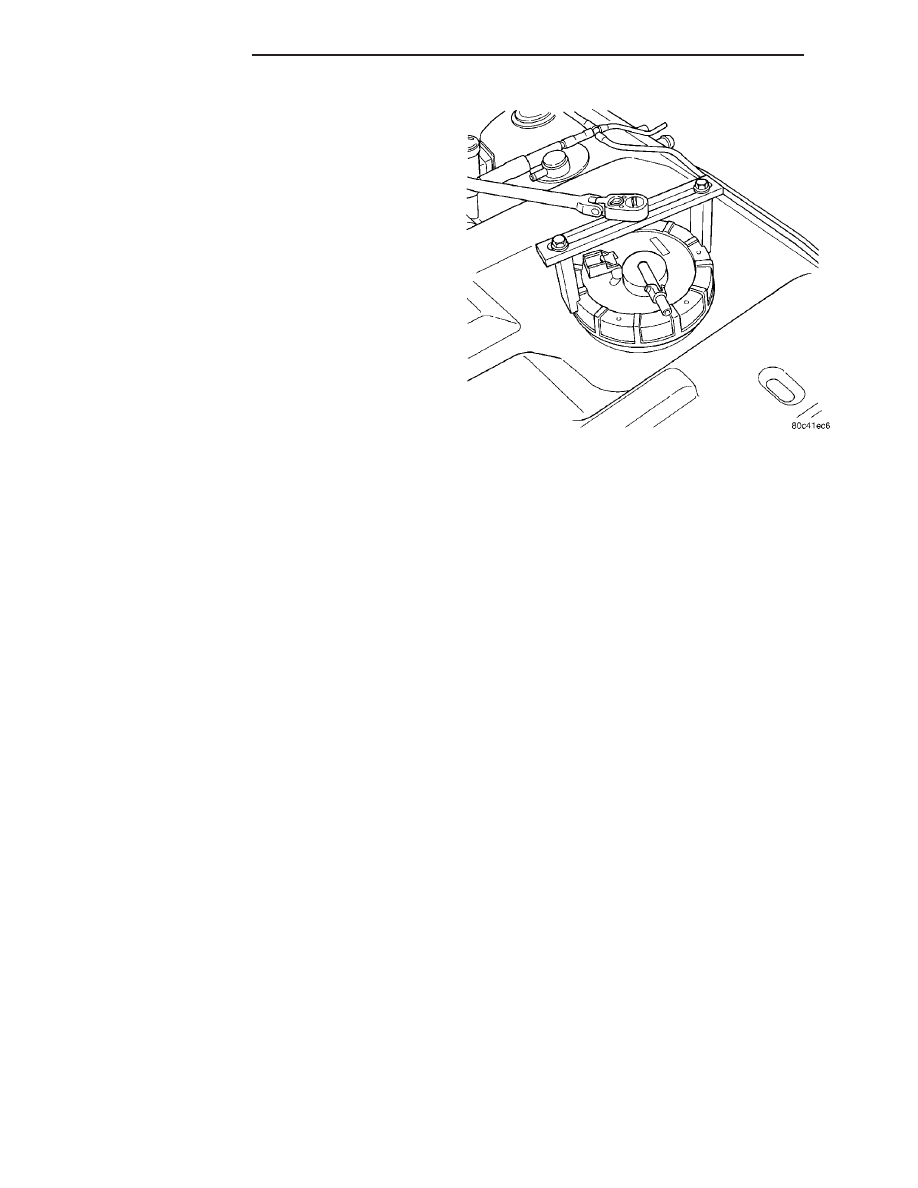Chrysler PT Cruiser. Manual - part 735

The fuel pump has a maximum deadheaded pres-
sure output of approximately 880 kPa (130 psi). The
regulator adjusts fuel system pressure to approxi-
mately 400 ±34 kPa (58 ±5 psi).
FUEL PUMP ELECTRICAL CONTROL
Voltage to operate the electric pump is supplied
through the fuel pump relay. For an electrical opera-
tional description of the fuel pump refer to fuel Pump
Relay—PCM Output.
ELECTRICAL PUMP REPLACEMENT
The electric fuel pump is not serviceable. If the
fuel pump or electrical wiring harness needs replace-
ment, the complete fuel pump module must be
replaced. Perform the Fuel System Pressure Release
procedure before servicing the fuel pump.
REMOVAL
WARNING: RELEASE FUEL SYSTEM PRESSURE
BEFORE SERVICING FUEL SYSTEM COMPONENTS.
SERVICE VEHICLES IN WELL VENTILATED AREAS
AND AVOID IGNITION SOURCES. NEVER SMOKE
WHILE
SERVICING
THE
VEHICLE.
THIS
MAY
RESULT IN PERSONAL INJURY OR DEATH.
(1) Remove fuel filler cap and perform Fuel Sys-
tem Pressure Release procedure.
(2) Remove the air cleaner lid, disconnect the inlet
air temperature sensor and makeup air hose.
(3) Remove the negative battery cable.
(4) Raise vehicle and support.
(5) Remove fuel tank, refer to the Fuel Tank
Removal in this section.
(6) Clean top of tank to remove loose dirt and
debris.
(7) Mark the fuel pump location on the top of
the fuel tank.
NOTE: The pump has to be properly located to the
tank for the fuel gauge to work properly.
(8) Disconnect fuel filter lines from fuel pump
module.
(9) Using Special Tool #6856 Fuel Pump Module
Ring Spanner, remove locknut to release pump mod-
ule (Fig. 10).
WARNING: THE FUEL RESERVOIR OF THE FUEL
PUMP MODULE DOES NOT EMPTY OUT WHEN THE
TANK IS DRAINED. THE FUEL IN THE RESERVOIR
MAY SPILL OUT WHEN THE MODULE IS REMOVED.
USE CAUTION TO AVOID PERSONAL INJURY.
(10) Remove fuel pump module and seal from
tank. Discard seal.
INSTALLATION
(1) Wipe seal area of tank clean. Place a new seal
between the tank threads and the pump module
opening.
NOTE: The pump has to properly located to the
tank for the fuel gauge to work properly.
(2) Position fuel pump module in tank. Make sure
the alignment marks line up on the fuel tank and
pump module.
CAUTION: Over tightening the pump lock ring may
result in a leak.
(3) While holding the pump module in position,
install locknut. Tighten locknut to 74.5 N·m (55 ft.
lbs) torque using special tool #6856.
(4) Install fuel tank, refer to the Fuel Tank Instal-
lation in this section.
(5) Lower vehicle.
(6) Install the negative battery cable.
(7) Install the air cleaner lid, connect the inlet air
temperature sensor and makeup air hose.
(8) Fill fuel tank with clean fuel. Use the DRBIII
t
scan tool to pressurize the system and check for
leaks.
FUEL RAIL
DESCRIPTION
The fuel rail supplies the necessary fuel to each
individual fuel injector and is mounted to the intake
manifold (Fig. 11).
Fig. 10 Fuel Pump Module Locknut
14 - 8
FUEL DELIVERY
PT
FUEL PUMP MODULE (Continued)